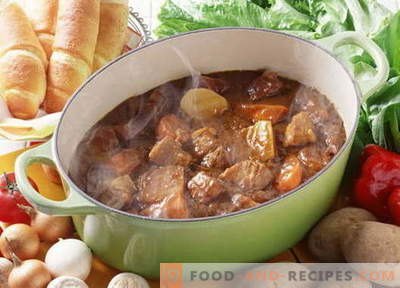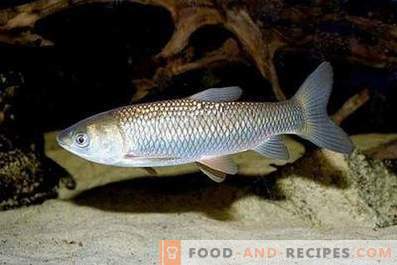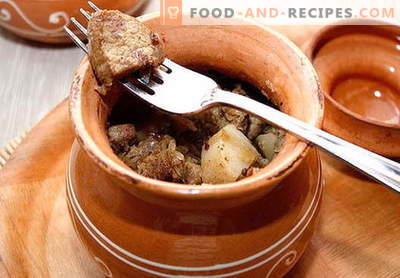
Pork is one of the most popular types of meat on our planet. The dishes prepared from it are the basis of the national cuisines of the countries of Southeast Asia, Europe, the Far East and North America. Pork meat products are widely popular in other parts of our planet. Prohibitions or restrictions on their consumption are established only in those states whose population professes Islam or Judaism.
Pork is eaten in boiled, fried and stewed form, used to make soups, kebab, aspic, schnitzel, stews, meatballs and other meat dishes. In addition, pork and offal is processed into sausages, sausages and wieners, smoked products are made on their basis (bacon, ham, bacon, etc.). Sometimes the whole pig is roasted as a separate dish.
There are two varieties of pork. K pork first grade include:
- spatula parts - directly the spatula and spatula meat on the bone (used in cooking soups, cutlets, roasts, stuffed and stewed dishes);
- loin - cutlet meat, boneless back and bone loin (suitable for making chops on the bone, schnitzels, escalopes, kebabs, roasts);
- boneless brisket and bone (used for soups and roasts);
- plow - muscle tissues of the abdominal muscles of the pig (used in the preparation of borscht, soups, roasts);
- lumbar part - thick sirloin and tenderloin (suitable for making escalopes, soups, roasts, kebabs, goulash);
- boneless ham and on the bone, filet of ham (fried and stewed whole, used to make minced meatballs, roast, boil broths).
Pork second-class meat recognizes:
- knuckle and shank - forearm and shin of the pig's legs (used for cooking soups, fried, stewed);
- tanks with a cervical notch - cheek meat, boneless neck and bone neck (used for stewing, cooking meat on the grill, roast).
Nutritional value of pork and vitamins in its composition
The nutritional value of pork depends on which part of the pork carcass meat was cut from. On average, a portion of a product weighing 100 g contains:
- 14, 297 g of proteins;
- 33, 278 g of fat;
- 51, 419 g of water;
- 0, 814 g of ash;
- 0, 218 g of omega-3 fatty acids;
- 3, 417 g of omega-6 fatty acids;
- 69, 814 mg of cholesterol.
Vitamins in pork (per 100 g serving):
- 0, 519 mg of thiamine (B1);
- 4, 094 μg of folate (B9);
- 0, 469 mg of pantothenic acid (B5);
- 0, 386 mg of tocopherol equivalent (E);
- 0, 139 mg of riboflavin (B2);
- 5, 711 mg of niacin equivalent (PP);
- 0, 321 mg of pyridoxine (B6);
- 74, 446 mg of choline (B4).
Pork calories
- Calories of raw pork - 356, 693 kcal.
- Calorie content of lean pork tenderloin - 148, 599 kcal.
- Calories of stewed pork - 234, 818 kcal.
- Caloric content of boiled pork - 374, 668 kcal.
- Calories of fried pork - 488, 792 kcal.
- The caloric content of the pork shoulder is 256, 794 kcal.
- The caloric value of the breast (on the bone) - 173, 334 kcal.
- Calories of pork ham - 262, 476 kcal.
- Calories from pork neck - 266, 486 kcal.
- Caloric content of pork shish kebab - 287, 575 kcal.
- Calories of pork cutlets - 466, 878 kcal.
- Caloric value of breaded pork chops - 349, 462 kcal.
Useful items in pork
Macroelements per 100 g pork per serving:
- 284, 978 mg of potassium;
- 163, 127 mg of phosphorus;
- 23, 756 mg of magnesium;
- 219, 791 mg of sulfur;
- 57, 466 mg of sodium;
- 48, 512 mg of chlorine;
- 6, 914 mg of calcium.
Trace elements per 100 g serving of pork:
- 6, 579 mkg of iodine;
- 95,688 μg of copper;
- 7, 776 mcg cobalt;
- 69, 237 μg of fluorine;
- 12, 248 μg of nickel;
- 0, 028 mg of manganese;
- 13, 487 mcg of chromium;
- 12, 496 μg of molybdenum;
- 29, 884 mcg tin;
- 2, 064 mg of zinc;
- 1, 687 mg of iron.
Useful properties of pork
- Pork is a rich source of animal protein. Nutritionists recommend that athletes and workers engaged in hard work, regularly include in the diet prepared from her meals.
- Pork contains substances that improve brain function.
- Regular consumption of pork contributes to the activation of regeneration processes in the human body, helps to quickly restore power after heavy loads, debilitating diseases.
- Pork meat contains vitamins and other useful compounds that strengthen the body's defenses and help it resist infections.
- Pork is a rich source of zinc and potassium. Regular consumption of pork meat helps to strengthen bone tissue and helps them recover faster after fractures and other injuries.
- Vitamins of group B, contained in pork, activate lipid, carbohydrate and protein metabolism. Compounds belonging to this group have a positive effect on the work of the central nervous system, help keep it in shape, effectively cope with irritability, neurosis, insomnia. According to some nutritionists, pork is a powerful natural antidepressant.
- Pork contains substances that positively affect the potency in men, normalizing the reproductive system in women. Useful compounds present in its composition, improve the composition of the ejaculate and reduce the risks of male infertility.
- Low-fat pork meat contains a lot of iron and other beneficial substances that improve the functioning of the blood system. That is why nutritionists recommend people who have been diagnosed with anemia, at least once a week to include in the diet of lean pork tenderloin dishes.
- According to nutritionists, regular consumption of pork meat has a positive effect on milk production in nursing mothers.
Contraindications and harm to pork
- Pork is oversaturated with growth hormone. Excessive intake of this compound into the human body together with food leads to the development of inflammatory and hypertrophic processes, increases the risk of benign and cancerous tumor neoplasms.
- Pork contains a lot of histamine. Excessive accumulation of this compound in the body increases the risk of allergic reactions, inflammatory processes, diseases of the biliary tract, thrombophlebitis, phlegmon and abscesses. The excess of histamine contributes to the emergence of a number of dermatological diseases (dermatosis, eczema, dermatitis, etc.), leads to the development of shock conditions and collapse. In addition, regular intake of large doses of it can lead to the development of arrhythmias, pre-infarction conditions, myocardial infarction and other cardiac pathologies.
- According to a number of virologists, pigs' lung tissue used in the manufacture of sausages, sausages, wieners, etc., is a favorable environment for the influenza virus. Along with pork, viral agents enter the human body through the alimentary route. Upon the occurrence of favorable conditions for reproduction (spring avitaminosis, hypothermia, heavy physical exertion, etc.), the virus is reactivated, causing the onset of the disease.
- Pork is contraindicated for people suffering from diseases that develop against the background of low acidity of gastric juice.
- Pork is a fatty product with high energy value. Abuse of pork can lead to accelerated weight gain, the formation of cholesterol plaques on the vessel walls and the development of atherosclerosis.
- Persons suffering from kidney and gallbladder diseases are recommended to sharply limit the consumption of pork and dishes prepared on its basis.
- Pork is a favorable medium for reproduction and development of various parasites. If non-compliance with the requirements of hygiene when working with pork, as well as with insufficient heat treatment of products prepared on its basis, the risk of parasitic infestation significantly increases.
- Abuse of pork increases the risk of colorectal cancer and other cancers. The consumption rate of pork - no more than 200 g during the day.
How to choose and store pork correctly?
When buying pork in stores and markets, you need to pay attention to the following points.
- Fresh pork has a light pink shade, on its surface iridescent colors never appear. Too dark meat is obtained by slaughtering middle-aged animals: the dishes prepared on its basis are tasteless and tough. And, on the contrary, too light shade of pork indicates that the diet of the slaughtered pig was oversaturated with hormonal drugs that could adversely affect human health.
- The surface of the pork meat must be dry. In the packaging used for packing pork, there should be no liquid.
- Fresh pork has almost no smell. Sometimes unscrupulous sellers try to hide the smell of spoiled meat by treating the product with a solution of potassium permanganate or vinegar.
- High-quality pork meat has a dense and elastic structure: after pressing with a finger, no dents are formed on its surface. Loose consistency is a sign of meat spoilage or excessive hormone preparations.
- Repeated freezing of pork significantly impairs its nutritional and taste properties. The fact of secondary freezing is easy to install on the small pink ice crystals present in the meat.
Fresh pork can be stored in the refrigerator for up to a week. It should not be used for storing sealed packaging: it is best to put the meat in a deep bowl or pan with a lid. Frozen pork can be stored in the freezer for about six months.























